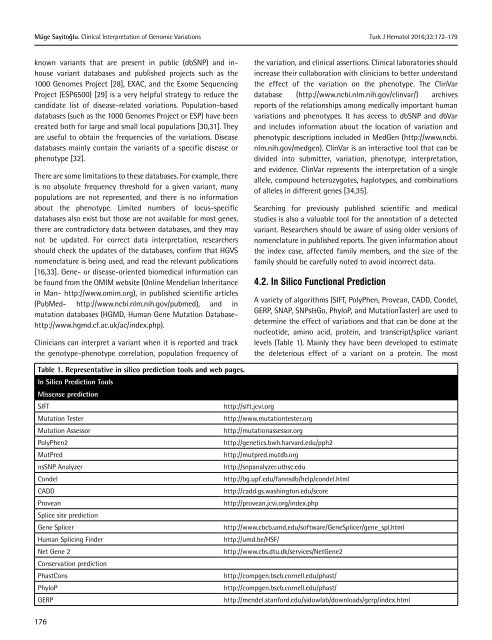Turkish Journal of Hematology Volume: 33 - Issue: 3
You also want an ePaper? Increase the reach of your titles
YUMPU automatically turns print PDFs into web optimized ePapers that Google loves.
Müge Sayitoğlu. Clinical Interpretation <strong>of</strong> Genomic Variations<br />
Turk J Hematol 2016;<strong>33</strong>:172-179<br />
known variants that are present in public (dbSNP) and inhouse<br />
variant databases and published projects such as the<br />
1000 Genomes Project [28], EXAC, and the Exome Sequencing<br />
Project (ESP6500) [29] is a very helpful strategy to reduce the<br />
candidate list <strong>of</strong> disease-related variations. Population-based<br />
databases (such as the 1000 Genomes Project or ESP) have been<br />
created both for large and small local populations [30,31]. They<br />
are useful to obtain the frequencies <strong>of</strong> the variations. Disease<br />
databases mainly contain the variants <strong>of</strong> a specific disease or<br />
phenotype [32].<br />
There are some limitations to these databases. For example, there<br />
is no absolute frequency threshold for a given variant, many<br />
populations are not represented, and there is no information<br />
about the phenotype. Limited numbers <strong>of</strong> locus-specific<br />
databases also exist but those are not available for most genes,<br />
there are contradictory data between databases, and they may<br />
not be updated. For correct data interpretation, researchers<br />
should check the updates <strong>of</strong> the databases, confirm that HGVS<br />
nomenclature is being used, and read the relevant publications<br />
[16,<strong>33</strong>]. Gene- or disease-oriented biomedical information can<br />
be found from the OMIM website (Online Mendelian Inheritance<br />
in Man- http://www.omim.org), in published scientific articles<br />
(PubMed- http://www.ncbi.nlm.nih.gov/pubmed), and in<br />
mutation databases (HGMD, Human Gene Mutation Databasehttp://www.hgmd.cf.ac.uk/ac/index.php).<br />
Clinicians can interpret a variant when it is reported and track<br />
the genotype-phenotype correlation, population frequency <strong>of</strong><br />
the variation, and clinical assertions. Clinical laboratories should<br />
increase their collaboration with clinicians to better understand<br />
the effect <strong>of</strong> the variation on the phenotype. The ClinVar<br />
database (http://www.ncbi.nlm.nih.gov/clinvar/) archives<br />
reports <strong>of</strong> the relationships among medically important human<br />
variations and phenotypes. It has access to dbSNP and dbVar<br />
and includes information about the location <strong>of</strong> variation and<br />
phenotypic descriptions included in MedGen (http://www.ncbi.<br />
nlm.nih.gov/medgen). ClinVar is an interactive tool that can be<br />
divided into submitter, variation, phenotype, interpretation,<br />
and evidence. ClinVar represents the interpretation <strong>of</strong> a single<br />
allele, compound heterozygotes, haplotypes, and combinations<br />
<strong>of</strong> alleles in different genes [34,35].<br />
Searching for previously published scientific and medical<br />
studies is also a valuable tool for the annotation <strong>of</strong> a detected<br />
variant. Researchers should be aware <strong>of</strong> using older versions <strong>of</strong><br />
nomenclature in published reports. The given information about<br />
the index case, affected family members, and the size <strong>of</strong> the<br />
family should be carefully noted to avoid incorrect data.<br />
4.2. In Silico Functional Prediction<br />
A variety <strong>of</strong> algorithms (SIFT, PolyPhen, Provean, CADD, Condel,<br />
GERP, SNAP, SNPs&Go, PhyloP, and MutationTaster) are used to<br />
determine the effect <strong>of</strong> variations and that can be done at the<br />
nucleotide, amino acid, protein, and transcript/splice variant<br />
levels (Table 1). Mainly they have been developed to estimate<br />
the deleterious effect <strong>of</strong> a variant on a protein. The most<br />
Table 1. Representative in silico prediction tools and web pages.<br />
In Silico Prediction Tools<br />
Missense prediction<br />
SIFT<br />
http://sift.jcvi.org<br />
Mutation Tester<br />
http://www.mutationtester.org<br />
Mutation Assessor<br />
http://mutationassessor.org<br />
PolyPhen2<br />
http://genetics.bwh.harvard.edu/pph2<br />
MutPred<br />
http://mutpred.mutdb.org<br />
nsSNP Analyzer<br />
http://snpanalyzer.uthsc.edu<br />
Condel<br />
http://bg.upf.edu/fannsdb/help/condel.html<br />
CADD<br />
http://cadd.gs.washington.edu/score<br />
Provean<br />
http://provean.jcvi.org/index.php<br />
Splice site prediction<br />
Gene Splicer<br />
http://www.cbcb.umd.edu/s<strong>of</strong>tware/GeneSplicer/gene_spl.html<br />
Human Splicing Finder<br />
http://umd.be/HSF/<br />
Net Gene 2<br />
http://www.cbs.dtu.dk/services/NetGene2<br />
Conservation prediction<br />
PhastCons<br />
http://compgen.bscb.cornell.edu/phast/<br />
PhyloP<br />
http://compgen.bscb.cornell.edu/phast/<br />
GERP<br />
http://mendel.stanford.edu/sidowlab/downloads/gerp/index.html<br />
176

















